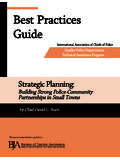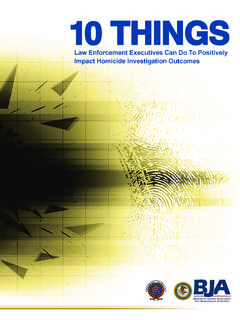Transcription of Best Practices Guide
1 Best Practices Guide International Association of Chiefs of Police Strategic Planning: Building Strong Police Community Partnerships in Small Towns by Chief David L. Kurz This project supported by a grant from: SSmmaalllleerr PPoolliiccee DDeeppaarrttmmeennttss TTeecchhnniiccaall AAssssiissttaannccee PPrrooggrraamm- 1 - Best Practices Guide for Strategic Planning: Building Strong Police-Community Partnerships in Small Towns By Chief David L. Kurz, Durham, New Hampshire Police Department Motivation for the Strategic Plan: When the police department in Durham, New Hampshire wanted to develop a strategic plan, there was an acknowledgement that the approach must be different from those of larger police agencies who could focus more resources to complete the task. While the number of demands upon the smaller department and their limited personnel could legitimately justify not even exploring the topic, there was awareness that the department still needed to establish long-term goals and develop a strategy that would ensure success.
2 The excuse of being a small agency did not negate the need to plan for the future. The Durham strategic plan project is comprised of three separate phases, 1) a survey of citizen satisfaction with police services, 2) a SWOT (Strengths, Weaknesses, Opportunities, and Threats) exercise of all department personnel, a one-day SWOT exercise and planning session attended by police officers and later by community leaders, and 3) Fiscal planning, since as diverse as ideas may be, funding will ultimately determine the level of services that the organization can provide. At the conclusion of the analysis, the agency has an evolving set of goals and corresponding plans to reach them. It also has the renewed support and cooperation of the community it serves. Benefits of the Strategic Plan: 1. The Durham Police Department decided to treat its constituents as partners and customers; like any good business, it needed to find out what its customers wanted.
3 2. Community members have questions about police services and how they are delivered; it behooves police chiefs to provide the answers. 3. The responses to the department s SWOT taught the chief much more about his police officers views than what he could have learned otherwise. 4. Officers report that they are getting more respect and better cooperation from residents since the department launched the strategic plan initiative. Policing Durham Though the crime rate in Durham is among the lowest in the state, the town s police department has its hands full. With 20 sworn officers and 5 support staff, the CALEA accredited police department serves a fluctuating population comprised of full-time citizens and 14,000 students of the University of New Hampshire. The unique policing environment demands a balance between supporting the desires of the permanent residents and allowing responsible flexibility from college - 2 - students.
4 In many ways, the community is dominated by the UNH school year. Policing in this environment becomes extremely demanding, commencing at school opening, and lasting until Homecoming Weekend in late October. During this time 3,500 in-coming freshmen come to realize that Mom and Dad aren t around to tell them when to be home nor will they be checking their sobriety when they return. Many of Durham Police Department s clients are strangers to the area, have never been away from home, do not know their classmates, often make bad decisions with strangers, and ultimately abuse a variety of substances. Experimentation with alcohol dominates the social scene. In many ways, the officers are challenged with the dilemma of allowing students the flexibility to gain life experiences, living through those experiences, and simultaneously responding to the concerns and demands of permanent residents.
5 Durham residents have come to expect a professional and personal response to their calls for service and the department has long maintained a good relationship with the community. But there was reason for concern when a citizens group told the new police chief that the residents saw the department as distant from the people it served. And perception is reality; as law enforcement executives must learn early in their careers. If the department wanted to improve the community s impression of the police, an event needed to be created where the community and the police, together, would determine the direction of the agency. In other words, the department committed to treating its constituents as partners and customers and, like any good business, it needed to find out what its customers wanted. Treating Police Constituents as Valued Customers One value of embracing a business philosophy for a police agency is that it makes the public the ultimate arbiter of what constitutes quality policing.
6 Isn t this a component of community policing? In the truest sense of the term, community policing is a philosophy and not just a program. It is a philosophy that calls for police and community cooperation to determine the problems and desires of the community and develop a strategy of partnership that will address those needs. Community policing also reinvigorates the community s sense of responsibility for maintaining law and order. Law enforcement is ultimately responsible for protecting the public , but good community policing empowers citizens to do their part in sharing the responsibility for the collective community. While it is appropriate that we trust mechanics to fix our cars, we are not excused from our responsibility to check the oil every once and a while! citizens today routinely question government and their police managers about what services their police departments provide, and how they deliver them.
7 It behooves police chiefs to take the lead in providing these answers. An environment that encourages discussion and allows for community feedback is the foundation of any community policing initiative. The development of a strategic plan helped the Durham Police Department create such an environment. The Strategic Planning Initiative Unsure of how to launch a strategic planning initiative, the Durham Police Department began by doing some research. Several excellent resources are found at the Office of Community Oriented Policing at the Department of Justice, , and at the Community Policing Consortium, , where there are a host of community policing suggestions. Most of the literature on the subject suggested that strategic planning was time consuming, sapped limited human resources, and appeared too much for a small police agency like - 3 - Durham to initiate.
8 Nevertheless, the department felt that strategic planning would help to reveal the proper direction that the organization should take. The department embraced some basic principles of the business world, such as: Soliciting and valuing customer comments Monitoring performance Promoting continuous improvement Inviting worker participation Certain these methods could help the police achieve higher levels of customer satisfaction; the agency launched its strategic planning initiative with a community survey which hopefully would eliminate what the police may think the community wanted in police services. PHASE ONE: Community Survey Police executives frequently ask themselves and their agencies, how do citizens perceive crime in the community and how does it affect them? How is the agency delivering service and how does the community perceive the department?
9 Community surveys offer a significant opportunity of finding out. Several effective and cost-saving strategies that the department has employed to ease the challenges of development, distribution and analysis of the responses include: Existing Surveys: The IACP has a number of examples of public safety and internal agency surveys on line at Durham ultimately arrived at a product that employs fifty questions to gauge customer satisfaction with the police force and concerns about crime and quality-of-life problems. To ensure that the responses will allow for conclusions, it is important that agencies employ mechanisms that are easily measured such as a scale rating of 1 to 5 with 5 meaning very good, yes or no, or true or false, etc. If questions allow for diverse answers, quantifying the responses will be extremely difficult and time consuming.
10 On-line Surveys: In this information driven age, the vast majority of our citizens have a computer or access to one. There are a host of free or inexpensive instruments that can be utilized to provide citizens with the opportunity to provide feedback to the police. An online search for free online surveys will offer a host of tools such as SurveyMonkey. However, police chiefs should be cognizant of the sophistication of the survey instrument and ensure that the survey tool allows for only one submission per IP address. Every agency has their supporters and detractors, and the question that there is potential skewing of the data negates the entire process. Expending even limited funds for a more robust product should be contemplated. Additionally, many instruments have the capacity to provide analyzed responses saving significant time and energy in correlation of the received data.









